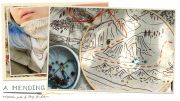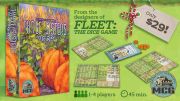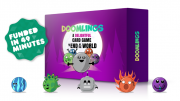Gift of Tulips (Weird Giraffe Games) – Each turn players draw a tulip card and either give it to another player for immediate points (points are equal to the card's value as well as that tulip color's current ranking in the festival), keeping it for end game scoring, or adding it to the tulip festival. When you add to the festival you either choose to place it straight there to affect that tulip type's current ranking, or place it in the hidden showcase. At the end of the game the cards in the showcase are revealed and added to the festival and players earn points for having the majority of a tulip type based on its ranking in the festival. After you resolve your first card on your turn, you then draw a second tulip card and must perform a different action than the one you chose for the first card.
Casual Games on Kickstarter: Tulips, Capers, and Sewing

From pleasant games of gifting one another tulips and growing your garden, to the belly of a beast and fighting over the last parachute, you can choose exactly how nice you want to be (or how backstabbing) this month on Kickstarter.
Caper: Europe (Keymaster Games) – Each round, both players will play a card from their hands to their own side of the board, at a specific location card. They will then swap hands. You continue to do this until there is only one card left in each hand, which is then discarded. There are two types of cards: thieves and gear. During the first round, you have a hand of thieves, while during the second round it is a hand of gear cards. Players alternate card types over six rounds. When playing gear, you must play it on one of the thieves you have already played, and each thief can hold up to three gear cards. Thieves earn you money when you play them, while gear will often cost money. There are multiple cities, each with different location cards, and different locations will have different abilities. Players must choose which city they'll be playing in at the start of the game, and this also affects the thieves and gear cards at your disposal.
So, You've Been Eaten. (LudiCreations) – One player is the miner who has been eaten by the beast, and the other player is the beast. The miner's goal is to capture all the crystal types in the beast while the beast is attempting to infect the miner. The miner rolls three action dice on his turn and then places them on his action track. Possible actions include pushing bacteria cards farther away from the miner on the board, capturing a crystal, adjusting the value of dice, or upgrading his action spaces. Then the bacteria attacks, moving one of the four types, one slot up its track, based on the card on the board closest to the miner. If one of the four types ever reaches the final slot of its track, the miner is infected and loses the game. On his turn, the beast player can refill the board with bacteria cards and can acquire special ability cards if he meets the necessary requirements (if he acquires five of these cards he also wins the game). There are also solo rules for playing as either the miner or the beast.
A Mending (Shing Yin Khor) – In this truly unique story telling solo game, you are plotting your path across a map to reach a friend. Prompt cards affect the story and the encounters you have along the way. While the game includes a paper map to play the game with, it also comes with a cloth map that you can sew your path into if you would rather play that way, creating what the designer calls a 'keepsake game'.
Three Sisters (Motor City Gameworks) – Three Sisters is a gardening themed roll-and-write game. The main board is placed in the center of the table and each player takes a scoring sheet. During the planning phase, all the dice are rolled, grouped in matching values, and then placed on the main board, placing them in ascending order on the action spaces. Players then take turns selecting a die. When you take a die you perform both a gardening action and the action indicated by the space it occupied on the board. For the gardening action, you look at the number and then either plant two new crops in the zone whose number matches the die, or water all the plants in that zone. The board actions include things such as filling in boxes in your apiary or fruit gardens, or filling in a box in your shed. Completing items in your shed unlocks bonus abilities. After each player has selected and resolved a die, everyone then resolves the lowest valued die still on the main board. Finally, the round ends with the event phase, in which all players resolve an event based on the current round. The game ends after eight rounds and the player with the highest score wins.
Hit the Silk! (Escape Plan) – The plane is crashing! But there aren't enough parachutes for all players. In this semi-cooperative game, you must all collect enough money cards as a team to win and a parachute card for yourself. A majority vote will cause the players with a chute to jump from the plane, or you will be forced to jump once the plane has lost enough altitude. Even once all players with parachutes have jumped, anyone remaining on board can attempt to land the plane with a dice mini-game. At the start of the game, everyone draws six cards. Cards can include money, parachutes, actions, and weapons. Each player chooses four cards to keep and openly discards the other two. On your turn you can change cards (trading cards in your hand for those from the deck), offer trades with other players (in which cards are exchanged in secret and backstabbing can occur), or play action cards. You can play as many action cards as you wish from your hand. Every choice you make and action you take causes the plane to lose more altitude, so you need to choose wisely.
Doomlings (Mccoy & Meyer) – In this card game about the end of the world, each player is evolving a new life form and giving it unique traits in a doomed world. Each round, a new age card is drawn which will change the rules for the round. Sometimes it is a catastrophe that will have a negative impact. Then each player takes turns playing a trait card to their trait piles, before drawing new cards. Traits come in different colors. Most have a point value and some have actions that trigger when played to your pile. Actions are varied such as increasing your hand size or allowing you to affect another player's trait pile, and trait colors will often affect how an ability is resolved. Some traits are dominant traits which are particularly powerful, but you may only have two of them in your trait pile. The game ends once the third catastrophe is drawn from the age deck, and then players count up the points in their trait piles. You can read our review of Doomlings here.
Disclosure: unless otherwise noted, we have not seen or played any of the above games. Our assessment of each is based on the information given on the crowdfunding project page.











